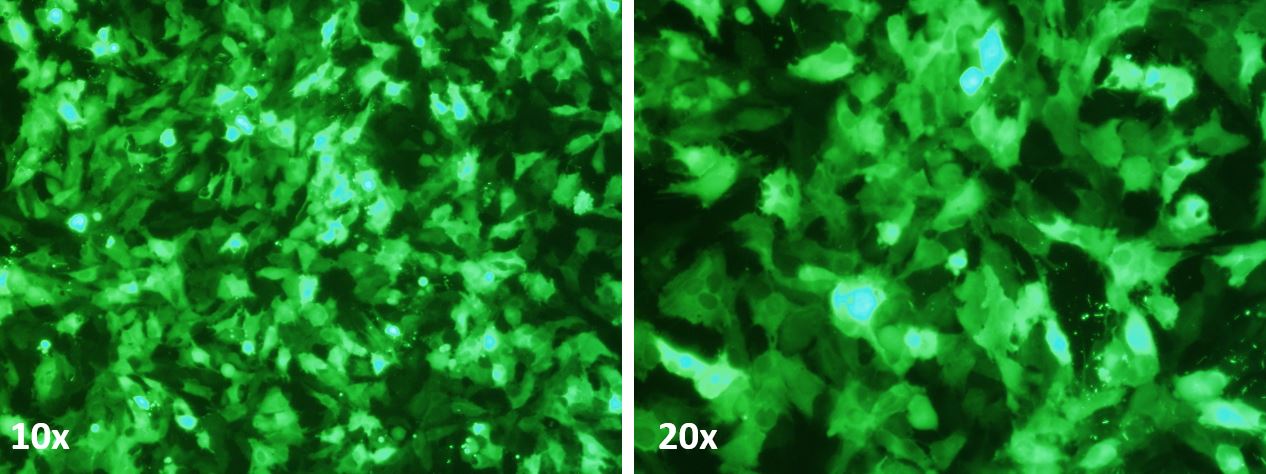Description
Cells to transfect:
Cell Line Name: Hs 578T
Cell Synonyms: ATCC HTB 126; ECACC 86082104; SPBIC, NCI60, NCI-60
Cell Synonyms: : ATCC HTB 126; ECACC 86082104; SPBIC.
Tissue: mammary gland; breast
Cell Type: fibroblast
Morphology: epithelial
Culture Properties: adherent
Mode of cultivation: monolayer
Tumorigenicity: tumorigenic in immunosupressed mice
Disease: ductal breast carcinoma
Age: 74 years adult
Gender: female
Ethnicity: Caucasian
Applications: antitumor tests, radiotherapy, tumorigenicity:
Comments:
The Hs 578T line was originated by A.J. Hackett, et al. along with the Hs 578Bst (see ATCC HTB-125), which is a normal fibroblast-like line from the same patient (J.Natl.Cancer Inst. 1977. 58: 1795-1806). The Hs 578T line had a mixed polygonal morphology initially, but a stellate cell type was selected for during passage and by cloning. As with Hs 578Bst, no estrogen receptors or endogenous viruses were detected.
Hs 578T is one of the cell lines of the NCI-60 panel which represents different cancer types and has been widely utilized for drug screening and molecular target identification.
Transfection reagent features:
- Broad spectrum for the transfection of large plasmid, mRNA, siRNA, and/or other type of nucleic acids, which is best for co-transfection of different type and/or size of nucleic acids.
- Unique formulation-maximize transfection performance in Hs 578T cells
- Extremely gentle to cells
- Much less reagent needed for each transfection: 0.5 ml is able to transfect about 1000 wells of 24-well plate
- Deliver single or multiple plasmids
- Free of animal-derived components
- Active in serum-containing medium
- Suitable for Reverse Transfection
- Compatible with transfection in any plate format
- Reproducible: due to highly controlled chemical synthesis of each of the ingredients, the reagent forms uniformly sized complex particles with nucleic acids. With optimized protocol, our reagent will ensure the reproducible highest transfection results.
- Great pricingDeveloped and manufactured by EZ Biosystems
Data
 FIG. 1. High throughput test of transfection efficiency (determined as RLU/mg) on Hs 578T cells after transfection of luciferase reporter gene by using our 172 proprietary transfection formulas and several most popular commercial transfection reagents. The yellow box showed the results of 4 commercial transfection reagents. The red lines marked our candidate formulas with the highest transfection efficiency for Hs 578T cells. This test result was confirmed with repeat experiments. The one that showed the optimal balance of potent & low cytotoxicity among those candidate formulas after flow cytometry analysis on the percentage of 7AAD positive cells was later named as this Hs 578T Cell Avalanche® Transfection Reagent.
FIG. 1. High throughput test of transfection efficiency (determined as RLU/mg) on Hs 578T cells after transfection of luciferase reporter gene by using our 172 proprietary transfection formulas and several most popular commercial transfection reagents. The yellow box showed the results of 4 commercial transfection reagents. The red lines marked our candidate formulas with the highest transfection efficiency for Hs 578T cells. This test result was confirmed with repeat experiments. The one that showed the optimal balance of potent & low cytotoxicity among those candidate formulas after flow cytometry analysis on the percentage of 7AAD positive cells was later named as this Hs 578T Cell Avalanche® Transfection Reagent.
 FIG. 2. Hs 578T cells were transfected with GFP vector (pEGFP-N3) by using Hs 578T Cell Avalanche® Transfection Reagent. The cells were visualized by Nikon Eclipse Fluorescence microscope 48 hours post transfection.
FIG. 2. Hs 578T cells were transfected with GFP vector (pEGFP-N3) by using Hs 578T Cell Avalanche® Transfection Reagent. The cells were visualized by Nikon Eclipse Fluorescence microscope 48 hours post transfection.
For Other Cells
Hs 578T Cell Avalanche® Transfection Reagent (human breast carcinoma cell) can also be used on the following cells with high transfection efficiencies.
BT-20 Cell
HCC1937 Cell
MCF7 cell
T47D cell
MDA-MB-468 Cell
SK-BR-3 Cell
MDA-MB-231 Cell
293 Cell
293T/17 Cell
Recommended protocols for these cells will be provided with the reagent. The protocols usually provide satisfactory transfection efficiency with invisible cytotoxicity. However, optimization may be needed for certain type of cells. Optimizations may include: the amount of DNA and this transfection reagent; cell density; transfection reagent/DNA ratio, or incubation time for the mixture of transfection reagent/DNA etc. For best transfection result, we recommend using the respective cell type/cell line specific Avalanche transfection reagents. Those reagents have been optimized on both recipes and protocols, and have been proved to have the best transfection results for the respective cell lines or primary cells. You can easily find the respective Avalanche transfection reagents specific for your cells by using the filters of our product list.
Additional Information
| Weight | 0.5 lbs |
|---|---|
| Adherence Phenotype |
Adherent |
| Cell Type |
Fibroblast |
| Disease |
Cancer |
| Names starting from |
H |
| Primary/Cell Line |
Cell Line |
| Product Sizes |
0.5 ml, 1.5 ml |
| Species |
Human |
| Tissue Sources |
Breast/Mammary |
| Subcategories |
Cell Type/Cell Line Specific |
Documents
Protocols
MSDS
Citations or Feedback


